| Paxillosida | |
|---|---|
 | |
| Luidia magnifica | |
| Scientific classification | |
| Domain: | Eukaryota |
| Kingdom: | Animalia |
| Phylum: | Echinodermata |
| Class: | Asteroidea |
| Superorder: | Valvatacea |
| Order: | Paxillosida Perrier, 1884 |
| Families | |
See text. | |
| Paxillosida | |
|---|---|
 | |
| Luidia magnifica | |
| Scientific classification | |
| Domain: | Eukaryota |
| Kingdom: | Animalia |
| Phylum: | Echinodermata |
| Class: | Asteroidea |
| Superorder: | Valvatacea |
| Order: | Paxillosida Perrier, 1884 |
| Families | |
See text. | |
Paxillosida adults lack an anus and have no suckers on their tube feet. They do not develop the brachiolaria stage in their early development. [1] They possess marginal plates, and have sessile pedicellariae. They mostly inhabit soft-bottomed environments of sand or mud. [2]
Recent analyses suggest Paxillosida may be a sister taxon of Asterina. [1] The order is divided into these families: [3]

Starfish or sea stars are star-shaped echinoderms belonging to the class Asteroidea. Common usage frequently finds these names being also applied to ophiuroids, which are correctly referred to as brittle stars or basket stars. Starfish are also known as asteroids due to being in the class Asteroidea. About 1,900 species of starfish live on the seabed in all the world's oceans, from warm, tropical zones to frigid, polar regions. They are found from the intertidal zone down to abyssal depths, at 6,000 m (20,000 ft) below the surface.

A brachiolaria is the second stage of larval development in many starfishes. It follows the bipinnaria. Brachiolaria have bilateral symmetry, unlike the adult starfish, which have a pentaradial symmetry. Starfish of the order Paxillosida have no brachiolaria stage, with the bipinnaria developing directly into an adult.
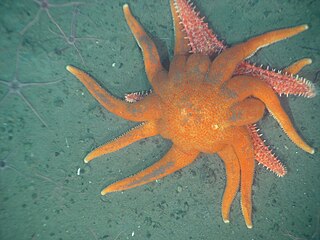
The Valvatida are an order of starfish in the class Asteroidea, which contains 695 species in 172 genera in 17 families.

The Astropectinidae are a family of sea stars in the order Paxillosida. Usually, these starfish live on the seabed and immerse themselves in soft sediment such as sand and mud.

Astropecten is a genus of sea stars of the family Astropectinidae.

The Forcipulatida are an order of sea stars, containing three families and 49 genera.
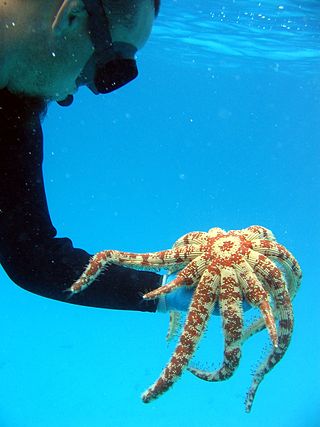
Luidia is a genus of starfish in the family Luidiidae in which it is the only genus. Species of the family have a cosmopolitan distribution.

Astropecten irregularis is a sea star of the family Astropectinidae. Common names include Sand sea star.

Luidia senegalensis, the nine-armed sea star, is a tropical species of starfish in the family Luidiidae found in the western Atlantic Ocean.

Luidia foliolata, the sand star, is a species of starfish in the family Luidiidae found in the northeastern Pacific Ocean on sandy and muddy seabeds at depths to about 600 m (2,000 ft).

The Porcellanasteridae are a family of sea stars in the order Paxillosida. These sea stars are found at abyssal depths. The World Asteroidea Database includes these genera in this family:

The spiny sand seastar is a species of starfish in the family Luidiidae. It is found in shallow parts of the China Sea and in the vicinity of the Korean archipelago. The tissues of this starfish have been found to contain several secondary metabolites with medicinal potential.

Astropecten scoparius is a sea star in the family Astropectinidae. It is found in shallow water in the East China Sea and around the coasts of Japan. It is a grey starfish and each of its five arms has a narrow pale margin. It burrows in the muddy sediments on the seabed and feeds on molluscs.
A paxilla is a small umbrella-shaped structure sometimes found on Echinoderms, particularly in starfish such as Luidia, Astropecten and Goniaster that immerse themselves in sediment. They are ossicles composed of calcite microcrystals found on the aboral (upper) surface of the animal. Their stalks emerge from the body wall and their umbrella-like crowns, each fringed with short spines, meet edge-to-edge forming a protective external false skin. The water-filled cavity beneath contains the madreporite and delicate gill structures known as papullae.

The Freyellidae are a family of deep-sea-dwelling starfish. It is one of two families in the order Brisingida. The majority of species in this family are found in Antarctic waters and near Australia. Other species have been found near New Zealand and the United States.
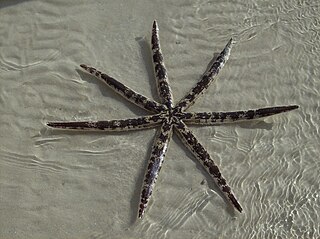
Luidia maculata is a species of starfish in the family Luidiidae in the order Paxillosida. It is native to the Indo-Pacific region. It is commonly known as the eight-armed sea star because, although the number of arms varies from five to nine, eight arms seems to be the most common.
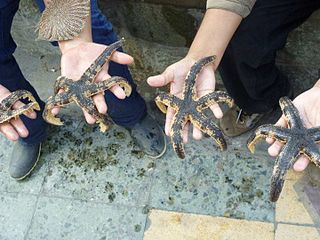
Luidia magellanica is a species of starfish in the family Luidiidae. It is found in the southeastern Pacific Ocean on the coast of South America.
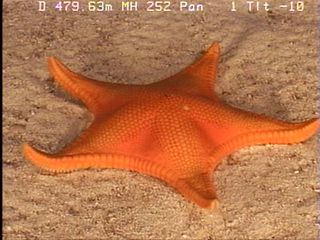
Pseudarchasteridae is a family of echinoderms belonging to the order Paxillosida.

Luidia savignyi is a species of starfish belonging to the family Luidiidae. The species is found in the tropical and subtropical Indo-Pacific region. It is a large starfish and preys on other echinoderms.